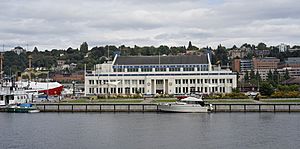Naval Reserve Armory facts for kids
Quick facts for kids |
|
|
Naval Reserve Armory
|
|

Naval Reserve Armory and Lake Union Park as viewed from the Space Needle
|
|
| Location | 860 Terry Avenue North, Seattle, Washington, U.S. |
|---|---|
| Area | 1.42 acres (5,700 m2) |
| Built | 1941–1942 |
| Architect | B. Marcus Priteca, William R. Grant |
| Architectural style | Moderne, Art Deco |
| NRHP reference No. | 09000506 |
| Added to NRHP | July 8, 2009 |
The Naval Reserve Armory is a historic building located in the South Lake Union area of Seattle, Washington. This large concrete building shows off the Moderne and Art Deco styles. It was built between 1941 and 1942 by the Works Progress Administration (WPA).
The main part of the building is a huge drill hall. This hall was used by the U.S. Naval Reserve. Thousands of young people trained here for service in World War II. The armory is important because it helped prepare many people for the war. It also shows how the government helped people find work during the Great Depression.
Building the Armory
The Naval Reserve Armory was designed by Seattle architects William R. Grant and B. Marcus Priteca. A group of citizens first suggested building it. However, some worried it would be too expensive to keep up.
Funding the Project
Later, local leaders supported the project. It received a large grant from the WPA, a government program that created jobs. The State of Washington and the University of Washington also helped pay for the construction.
The total cost to build the armory was about $500,000. It was officially opened on July 4, 1942. This was a difficult time during World War II. A special guest at the opening was Mrs. Peter Barber. Her three sons had sadly died in the Japanese attack on Pearl Harbor.
After the War
After World War II ended, the armory was no longer needed for naval training. It received money for repairs in 1946. The building was officially closed by the Navy in 1998.
Historic Recognition
The Naval Reserve Armory was added to the National Register of Historic Places (NRHP) on July 8, 2009. This list recognizes important historic places in the United States. In 2009, the building was still in very good condition.
A New Purpose

In 2012, the armory went through a big renovation. It became the new home for Seattle's Museum of History and Industry (MOHAI).
The building is now part of Lake Union Park. This park is at the south end of Lake Union. Lake Union is connected to Puget Sound by the Lake Washington Ship Canal. Before the armory was built, this spot was used by a sawmill called Eastern Mill.


